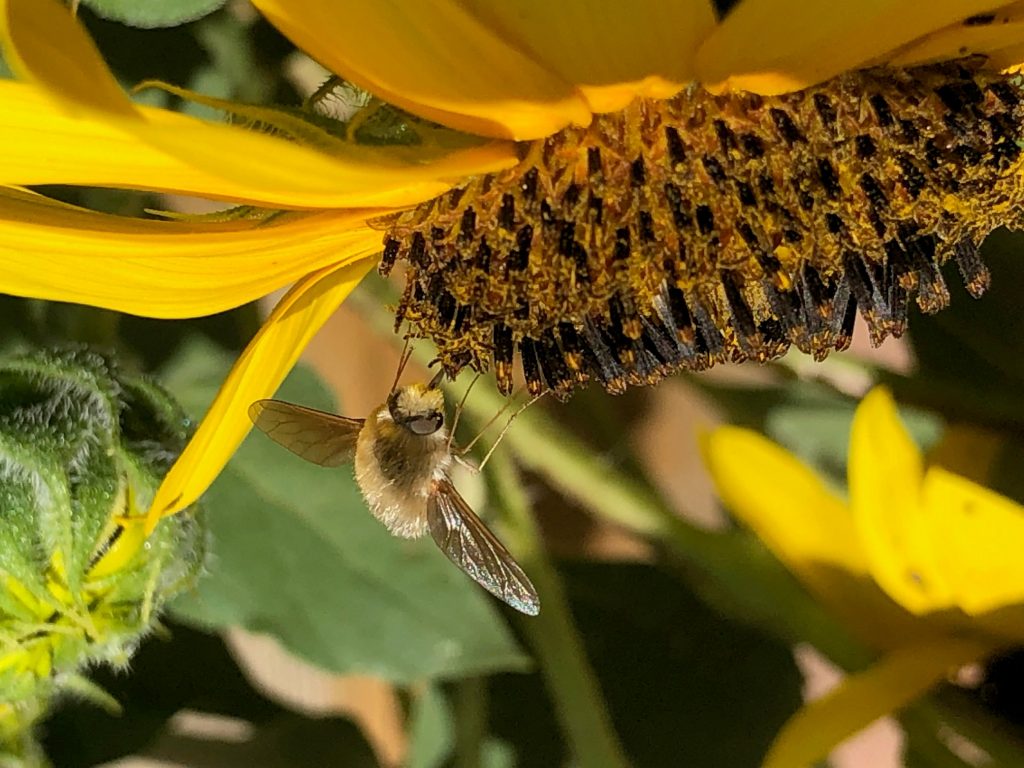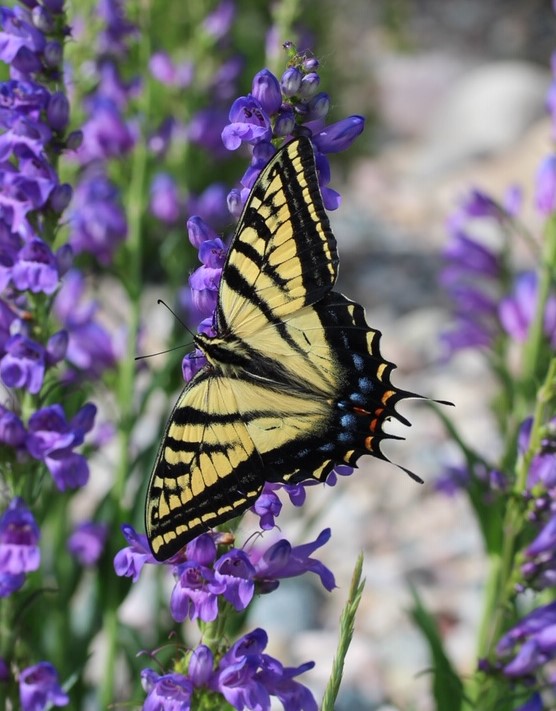From the Hort Desk – Plant It and They Will Come
- 2020-04-03
- By mkirk
- Posted in The Garden Buzz
By Lisa Mason, CSU Extension Horticulture Agent

Spring is a wonderful time to be outside. When you are outside, I encourage you to observe your surroundings, and notice not only the pollinators but other insect and animal visitors to our yards. No matter how small the space, an entire ecosystem is right before our eyes.
Pollinator gardens offer a variety of benefits for pollinating insects and animals and for people. Pollinator-friendly plants provide food sources including nectar (energy) and pollen (protein). Gardens should provide nesting places and water, making them even more attractive to pollinators. Providing these resources can benefit local pollinator populations, no matter how large or small the space.
So, who are the pollinators visiting our gardens?
After planting the Lima Plaza Pollinator Garden last September, we immediately saw a couple of pollinators, including bee flies and honey bees. This spring when the plants begin blooming, we anticipate seeing many other pollinators visiting the garden.

Flies
Flies are important pollinators in our gardens. Two common groups of flies that visit flowers are syrphid flies, also known as hover flies or flower flies (Family: Syrphidae) and bee flies (Family: Bombyliidae). They are often confused with bees and wasps because the flies mimic bees and wasps. This mimicry gives flies the appearance that they are stinging insects which may protect them from predators. Besides being pollinators, syrphid flies and hover flies also provide another benefit to our gardens—the larval stage of these flies are hungry predators and they feed on pest insects. Flies generally prefer shallow flowers for nectar and will visit a variety of plants.
Hummingbirds
Hummingbirds are another delightful visitor to pollinator gardens. The most common species of hummingbird in Arapahoe County is the broad-tailed hummingbird (Selasphorus platycercus). These tiny birds migrate long distances every year to Mexico and Central America! They arrive in Colorado around mid-April and leave in October. Hummingbirds need coverage in trees and shrubs to hide and nest. They are attracted to flowers that are bright red or orange and tubular. Flowers such as scarlet gilia (Ipomopsis aggregate), hyssop (Agastache spp.), firecracker penstemon (Penstemon eatonii), and bee balm (Monarda spp.) are all excellent choices. You can supplement their diet with a hummingbird feeder. Use a 4:1 ratio of water-to-sugar. Nature’s nectar is clear so avoid using red dyes. Be sure to replace the sugar solution every few days and keep the feeder and area clean. April is the best time to put out your hummingbird feeder.

Butterflies
Colorado has over 250 species of butterflies. Many are common in Arapahoe County including the painted lady (Vanessa cardui), two-tailed swallowtail (Papilio multicaudata), black swallowtail (Papilio polyxenes), and the occasional monarch (Danaus plexippus). Butterflies are most attracted to gardens that provide host plants for growing caterpillars. For example, two-tailed swallowtail caterpillars feed on green ash and chokecherries. The adults feed on nectar from thistles, milkweed, and other flowers. All butterflies need places to shelter in trees, but they also love open sunny areas. Butterflies are generally attracted to brightly colored flowers, especially reds and purples that provide nectar. They prefer flowers that have a wide landing pad. Here is a great fact sheet on attracting butterflies to your yard.

Bees
Bees are common visitors to pollinator-friendly flowers and gardens. Colorado has over 900 species of bees. Most of these bees are solitary bees. They nest underground or in cavities. Bees that nest underground prefer bare soil. Cavity nesting bees can nest in dead trees or logs, nooks and crannies in buildings, or bee hotels. Bees generally prefer flowers that are white, yellow, or blue/purple. They tend to visit flowers that have a landing place or are tubular-shaped or shallow. Many bee species are generalists, meaning they will forage on a variety of flower species. Some bee species have specialist relationships with their plants. You can read more about the variety of bees we have in Colorado here and attracting bees to your landscape here.
Understanding how native bees and honey bees interact and coexist continues to be a new area of research. Native bees are critical for our ecosystems and provide different pollination services than honey bees, as some native bees are very specialized with certain plants. For example, bumble bees pollinate tomatoes and peppers, which other bees cannot pollinate. The honey bee (Apis mellifera) is a non-native species but provides important pollination services for plants, crops, etc. Honey bees also provide honey and wax. By planting more floral resources in our pollinator gardens, we can help provide enough resources for all bees.
Other Pollinators
This is not a comprehensive list of all the pollinators we see in pollinator gardens. Other pollinators include moths, beetles, and some species of wasps. Bats and other mammals can pollinate plants in other parts of country and world. We hope you enjoy observing some of these pollinating visitors in your garden this summer. We look forward to watching them pollinate the new Lima Plaza Pollinator Garden.
Horticulture Resources
- Garden Buzz Archives
- CSU Extension Resources
- Colorado Master Gardener Program
- Foothills to Plains Native Plant Master Program
- Native Bee Watch Community Science Program
- The Co-Hort Blog
- PlantTalk Colorado
- Soil Testing
- Plant Select
- Emerald Ash Borer
- Japanese Beetle
- Colorado State Forest Service
- Ask an Expert


